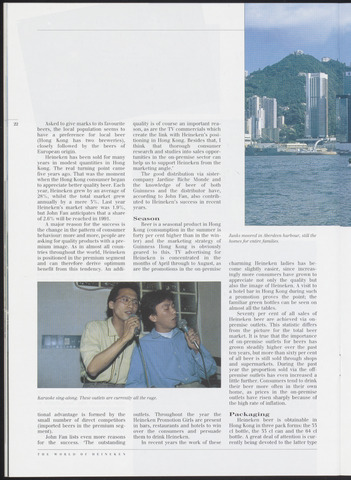Junks moored in Aberdeen harbour, still the
homes for entire families.
charming Heineken ladies has be
come slightly easier, since increas
ingly more consumers have grown to
appreciate not only the quality but
also the image of Heineken. A visit to
a hotel bar in Hong Kong during such
a promotion proves the point; the
familiar green bottles can be seen on
almost all the tables.
Seventy per cent of all sales of
Heineken beer are achieved via on-
premise outlets. This statistic differs
from the picture for the total beer
market. It is true that the importance
of on-premise outlets for beers has
grown steadily higher over the past
ten years, but more than sixty per cent
of all beer is still sold through shops
and supermarkets. During the past
year the proportion sold via the off-
premise outlets has even increased a
little further. Consumers tend to drink
their beer more often in their own
home, as prices in the on-premise
outlets have risen sharply because of
the high rate of inflation.
Packaging
Heineken beer is obtainable in
Hong Kong in three pack forms: the 35
cl bottle, the 33 cl can and the 64 cl
bottle. A great deal of attention is cur
rently being devoted to the latter type
Karaoke sing-along. These outlets are currently all the rage.
tional advantage is formed by the
small number of direct competitors
(imported beers in the premium seg
ment).
John Fan lists even more reasons
for the success. 'The outstanding
outlets. Throughout the year the
Heineken Promotion Girls are present
in bars, restaurants and hotels to win
over the consumers and persuade
them to drink Heineken.
In recent years the work of these
22 Asked to give marks to its favourite
beers, the local population seems to
have a preference for local beer
(Hong Kong has two breweries),
closely followed by the beers of
European origin.
Heineken has been sold for many
years in modest quantities in Hong
Kong. The real turning point came
five years ago. That was the moment
when the Hong Kong consumer began
to appreciate better quality beer. Each
year, Heineken grew by an average of
28%, whilst the total market grew
annually by a mere 3%. Last year
Heineken's market share was 1.9%,
but John Fan anticipates that a share
of 2.6% will be reached in 1991.
A major reason for the success is
the change in the pattern of consumer
behaviour: more and more, people are
asking for quality products with a pre
mium image. As in almost all coun
tries throughout the world, Heineken
is positioned in the premium segment
and can therefore derive optimum
benefit from this tendency. An addi-
quality is of course an important rea
son, as are the TV commercials which
create the link with Heineken's posi
tioning in Hong Kong. Besides that, I
think that thorough consumer
research and studies into sales oppor
tunities in the on-premise sector can
help us to support Heineken from the
marketing angle.'
The good distribution via sister-
company Jardine Riche Monde and
the knowledge of beer of both
Guinness and the distributor have,
according to John Fan, also contrib
uted to Heineken's success in recent
years.
Season
Beer is a seasonal product in Hong
Kong (consumption in the summer is
forty per cent higher than in the win
ter) and the marketing strategy of
Guinness Hong Kong is obviously
geared to this. TV advertising for
Heineken is concentrated in the
months of April through to August, as
are the promotions in the on-premise
T H E NV O R L D OF HEINEKEN

